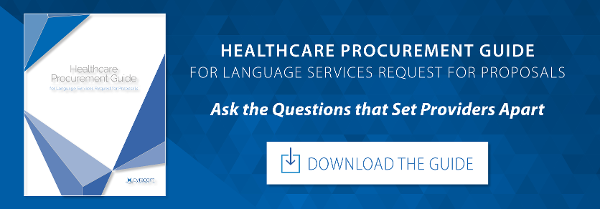
Choosing a language services provider for your hospital or healthcare organization is a significant responsibility. The Joint Commission has identified communication problems between providers and their patients as the root cause of one in five sentinel events in healthcare, so choosing a partner to provide a quality of interpretation and translation which ensures clear communication is crucial.
Unfortunately, some language services provider de-emphasize quality. They choose instead to rely on “free” giveaway items and race-to-the-bottom per-minute pricing to win business while neglecting the “fundamentals” that contribute to a professional quality of interpretation. Hospitals and healthcare organizations swayed by these tactics may find that the long-term consequences of poor-quality interpretation – unnecessary readmission, adverse outcomes for limited-English proficient (LEP) patients, and diminished HCAHPS scores, to name a few – far outweigh the perceived benefits of receiving a few “free” iPads.
But how do providers go about choosing a language services partner committed to quality? Here are four questions anyone shopping should ask, and an explanation of why they matter:
1. How many full-time employee (W-2) interpreters do you have? What percentage of total call volume is handled by full-time employee (W-2) interpreters?
Interpreters hired as employees can be trained to do the job well and assigned a set schedule of hours. In contrast, it’s unlawful for US corporations to train or schedule workers they designate as independent contractors. If you learn that a prospective US language services provider relies exclusively – or even primarily – on independent contractors to interpret, you’ve also learned that they cannot lawfully train or schedule those individuals as interpreters.
CyraCom hires and trains thousands of US employee interpreters and schedules them to meet client demand.
2. How many hours of initial training do you directly administer to new interpreters? Which healthcare-specific topics does training cover? Is your interpreter training classroom-based and taught by in-person instructors in the US? If not, what are other ways you provide training and how many hours does each training method represent?
Once you know that a language services provider can lawfully train their employee interpreters, it’s important to confirm that they do so. This includes examining the number of training hours new interpreters receive before they begin taking your patients’ calls, as well as the subject matter covered. Most vendors will claim to provide training. They may not tell you (unless asked) that it often takes place primarily online or over the phone. Verify that the vendor provides interpreter training in an environment conducive to learning.
CyraCom provides our employee interpreters with 120 hours of dedicated, in-person classroom training on the fundamentals of quality interpretation, as well as specific medical terminology and scenarios they may encounter taking healthcare calls.
3. How often do you proactively monitor calls for quality and which competencies does monitoring measure? How do you provide interpreters with coaching and specific feedback on call quality? When do you provide this feedback?
Quality monitoring plays a key role in ensuring that interpreters apply what they learned in training, and that they’re consistently following policy and procedure put in place to create quality interactions. You should assess the effectiveness of the vendor’s ongoing quality monitoring program.
You’ll also want to learn how the vendor remedies poor interpreter performance and awards outstanding performance. Coaching provided soon after the monitored call may prove more effective than coaching given days or weeks later.
CyraCom provides regular, scheduled quality monitoring to our employee interpreters, ensuring protocols are followed and quality remains high. We provide immediate coaching after monitoring to ensure any needed corrections are made quickly.
4. Please provide your definition of a “contact center,” and confirm that at-home/residential environments are never classified as a “contact center.” Please provide a list of addresses, interpreter seats, and square footages of all contact center locations. Please provide photographs of interpreter work locations.
Most language services providers implicitly recognize the advantages of having interpreters employed in a contact center environment (as opposed to working from home) by claiming to have these contact centers. But since “contact center” doesn’t have a set legal definition, it’s important to ask follow-up questions. We’ve encountered scenarios where competitors claimed small storefront offices with less than 10 people on-site, and even home offices, as “contact centers.”
CyraCom operates seven large-scale, US-based interpreter contact centers where we hire, train, and quality-monitor thousands of employee interpreters in a secure, well-regulated, supervised environment.
Asking these questions should help hospitals and healthcare organizations seeking a language services partner to ensure they receive quality interpreter services. To learn more about what to ask, download our free RFP Guide for healthcare here:




